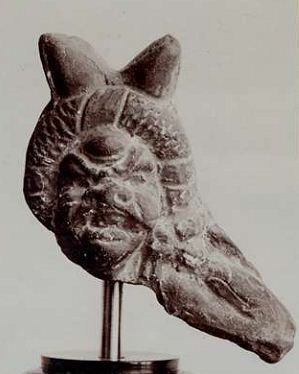
Classical Antiquities
| Date | 1st–3rd century A.D. |
|---|---|
| Object type | gem |
| Medium, technique | engraved, red jasper |
| Dimensions | 32.7 × 42.8 × 8.8 mm |
| Inventory number | 2002.6.A |
| Collection | Classical Antiquities |
| On view | Museum of Fine Arts, Basement Floor, Classical Antiquity, Eros – Dionysos – Thanatos |
Engraved precious stones (gems) had been produced in the cultures of classical antiquity from the very beginning. They had three main uses: as jewellery, as seals and as protective amulets. Their engraving in itself does not shed light on their original function. However, at the end of the 1st century B.C. some new variants appeared, which, based on their unique iconography and inscriptions, clearly had talismanic function. The modern term for these pieces is ‘magical gems’. Their appearance might not have been deemed significant in antiquity, so they had not been given a proper name of their own. Besides, at the time of their appearance the talismans displaying the century old, ‘traditional’ iconographic types of Graeco-Roman glyptics were also in use. The fact that magical gems were gaining ground did not represent the victory of magic over religion, as it is often thought today, since ancient cultures rarely drew a clear line between the two spheres. Most gems were used as ringstones, others as pendants or sewn into clothing.
Judging by its inscription, this red jasper gem was a votive gift: a man called Ophelimus made an offering of it, following a dream sent by a god (Ophelimus ex viso numinis posuit). But then the engraving, an absolutely unique series of pictures, which presents the story summed up by the inscription in a form resembling that of a comic strip, takes us well into the world of magic. Since the story presents a unique event in the life of a person who lived almost two thousand years ago, it is not possible to reconstruct more than an outline of it. Inferring from the inscription, a god appeared in the man’s dream and gave him advice. The god is represented in the middle of the gem in a size slightly bigger than that of the others below him, his right hand is raised in a gesture of greeting, in his left hand there is a burning torch. Following the advice, Ophelimus (who is to be identified with the kneeling figure) appeared as a supplicant before Hecate, the magician-goddess, who was presented in her customary ‘triformis’ figure with three bodies, as well as two whips, daggers and burning torches turned downwards in each hand. Next, Ophelimus offered a sacrifice at an altar.
The goddess granted the supplicant’s request. What this might have been is indicated by the outsize closing scene, which is quite unique in itself. Three women surround a bodyless head, which is thought to be the representation of a helping daimon. The engraving of the gem shows some marked resemblance with charms surviving in magic books, by which deities (among them Hecate) grant the supplicant a protector demon. Magical gems indicate the process through which the magical traditions of ancient Mediterranean cultures were integrated into an international discipline. Magic in the Roman Imperial Period was considered as a science – be it a direct technology ensuring health and prosperity, be it a search for conversing with the divine. The main reason why it became dynamic and supra-cultural was the fact that it was open towards everything it could use effectively. On the one hand, it made the long-accumulated knowledge of various cultures accessible for others, while on the other, it encouraged experimentation to seek new solutions. Even though the working principles of magical gems seem distant, at least two of their features might strike a chord even now. Their driving force was the need, the demand for knowledge that could be applied with success – as an old magician put it: ‘the one that is without real knowledge is a man in name only’. Besides, the desire of people for getting ahead (the fulfilment of which was expected of these gems centuries ago) is still on the agenda of mankind.
Following Árpád M. Nagy
Inscription in three lines: Ophelimus | ex visonumi | nis posuit → Ophelimus ex viso numinis posuit. ‘Ophelimus offered it, after a dream that a divinity had shown him.’
This record is subject to revision due to ongoing research.